Wetland
A wetland is a distinct ecosystem that is flooded by water, either permanently or seasonally, where oxygen-free processes prevail. The primary factor that distinguishes wetlands from other landforms or water bodies is the characteristic vegetation of aquatic plants, adapted to the unique hydric soil.
The Convention uses a broad definition of wetlands. It includes all lakes and rivers, underground aquifers, swamps and marshes, wet grasslands, peatland, oases, estuaries, deltas, and tidal flats, mangroves, and other coastal areas, coral reefs, and all human-made sites such as fish ponds, rice paddies, reservoirs, and salt pans.
Significance of Wetlands
- Wetlands are a critical part of our natural environment. They mitigate floods, protect coastlines and build community resilience to disasters, reduce the impacts of floods, absorb pollutants and improve water quality.
- Wetlands are critical to human and planet life. More than 1 billion people depend on them for a living and 40% of the world’s species live and breed in wetlands.
- They are a vital source for food, raw materials, genetic resources for medicines, and hydropower.
- 30% of land-based carbon is stored in peatland.
- They play an important role in transport, tourism, and the cultural and spiritual well-being of people.
- Many wetlands are areas of natural beauty and many are important to Aboriginal people.
Threats
- As per the IPBES (Intergovernmental Science-Policy Platform on Biodiversity and Ecosystem Services)’s global assessment wetlands are the most threatened ecosystem.
- Wetlands are disappearing 3 times faster than forests due to human activities and global warming.
- According to UNESCO, the threat to wetlands will have an adverse impact on 40% of the world’s flora and fauna that live or breed in wetlands.
- Major threats: Agriculture, development, pollution, and climate change.
IPBES
- IPBES is an independent intergovernmental body established to strengthen the science-policy interface for biodiversity and ecosystem services for the conservation and sustainable use of biodiversity, long-term human well-being, and sustainable development.
- It was established in Panama City (US), in April 2012.
- It is not a United Nations body.
Ramsar Convention on Wetlands
The term was coined when the International Treaty for the Conservation and Sustainable use of Wetlands was signed at a city of Iran called Ramsar in 1971.
It is also known as the Convention on Wetlands.
Ramsar Convention is a convention on wetlands that was signed in 1971 in the Iranian city of Ramsar. The negotiations for the convention started in the 1960s by the different countries and NGOs for the protection of wetland habitats of migratory waterbirds. Finally, it came into force in 1975.
February 2 is celebrated as International Wetlands Day as the Ramsar Convention was signed on February 2, 1971.
The Ramsar Convention works with the collaboration of the following organizations:
- International Union for Conservation of Nature (IUCN).
- Birdlife International.
- International Water Management Institute (IWMI).
- Wetlands International.
- Wildfowl & Wetlands Trust (WWT)
- WWF International
Under the “three pillars” of the Convention, the Contracting Parties commit to:
- work towards the wise use of all their wetlands;
- designate suitable wetlands for the list of Wetlands of International Importance (the “Ramsar List”) and ensure their effective management;
- cooperate internationally on transboundary wetlands, shared wetland systems, and shared species.
Ramsar Sites
Any Wetland site which has been listed under the Ramsar Convention that aims to conserve it and promote sustainable use of its natural resources is called a Ramsar Site.
At the time of joining the Convention, each Contracting Party undertakes to designate at least one wetland site for inclusion in the List of Wetlands of International Importance.
The inclusion of a “Ramsar Site” in the List embodies the government’s commitment to take the steps necessary to ensure that its ecological character is maintained.
The Ramsar sites are maintained in Montreux Record to track any major ecological changes that might affect any of the wetland sites positively or in a reverse way.
- The Montreux Record is a register of wetland sites on the List of Ramsar wetlands of international importance where changes in ecological character have occurred, are occurring, or are likely to occur as a result of technological developments, pollution, or other human interference. It is maintained as part of the Ramsar List.
- At present, two wetlands of India are in Montreux Record:
- Keoladeo National Park (Rajasthan) and
- Loktak Lake (Manipur).
- Note: Chilka Lake (Odisha) was placed in the record but was later removed from it.
There are currently over 2,400 Ramsar Sites on the territories of 171 Ramsar Contracting Parties across the world. They cover over 2.5 million square kilometers, an area larger than Mexico.
- India is a party to the Ramsar Convention. India signed under it on 1st February 1982.
- Sundarbans is the largest Ramsar Site of India.
- Chilika Lake (Orissa) and Keoladeo National Park (Rajasthan) were recognized as the first Ramsar Sites of India.
- Renuka Wetland (Area – 20 ha) in Himachal Pradesh is the smallest wetland of India.
- World’s First Ramsar site was identified in 1974, which was the Cobourg Peninsula in Australia.
Ramsar Sites in India
- The Ramsar convention entered into force in India on 1 February 1982.
- All wetlands, irrespective of their location, size, ownership, biodiversity, or ecosystem services values, can be notified under the Wetlands Rules 2017, except river channels, paddy fields, human-made waterbodies specifically constructed for drinking water, aquaculture, salt production, recreation, irrigation purposes, wetlands falling within areas covered under the Indian Forest Act, 1927, Forest (Conservation) Act, 1980, Wildlife (Protection) Act, 1972 and the Coastal Regulation Zone Notification, 2011.
- India has over 7 lakh wetlands, covering 4.5% of the country’s area, yet none of the wetlands has been notified under domestic laws.
- Wetlands are regulated under the Wetlands (Conservation and Management) Rules, 2017.
As of March 2024, there are 80 Ramsar Sites in India.
List of Ramsar sites in India
| S.No. | Ramsar Sites in India | State – Location |
|---|---|---|
| 1 | Ashtamudi Wetland | Kerala |
| 2 | Beas Conservation Reserve | Punjab |
| 3 | Bhitarkanika Mangroves | Odisha |
| 4 | Bhoj Wetlands | Madhya Pradesh |
| 5 | Chandra Taal | Himachal Pradesh |
| 6 | Chilika Lake | Odisha |
| 7 | Deepor Beel | Assam |
| 8 | East Kolkata Wetlands | West Bengal |
| 9 | Harike Wetlands | Punjab |
| 10 | Hokera Wetland | Jammu & Kashmir |
| 11 | Kanjli Wetland | Punjab |
| 12 | Keoladeo National Park | Rajasthan |
| 13 | Keshopur-Miani Community Reserve | Punjab |
| 14 | Kolleru lake | Andhra Pradesh |
| 15 | Loktak lake | Manipur |
| 16 | Nalsarovar Bird sanctuary | Gujarat |
| 17 | Nandur Madhameshwar | Maharashtra |
| 18 | Nangal Wildlife Sanctuary | Punjab |
| 19 | Nawabganj Bird Sanctuary | Uttar Pradesh |
| 20 | Parvati Arga Bird Sanctuary | Uttar Pradesh |
| 21 | Point Calimere Wildlife and Bird Sanctuary | Tamil Nadu |
| 22 | Pong Dam lake | Himachal Pradesh |
| 23 | Renuka lake | Himachal Pradesh |
| 24 | Ropar Wetland | Punjab |
| 25 | Rudrasagar Lake | Tripura |
| 26 | Saman Bird Sanctuary | Uttar Pradesh |
| 27 | Samaspur Bird Sanctuary | Uttar Pradesh |
| 28 | Sambhar lake | Rajasthan |
| 29 | Sandi Bird Sanctuary | Uttar Pradesh |
| 30 | Sarsai Nawar Jheel | Uttar Pradesh |
| 31 | Sasthamkotta lake | Kerala |
| 32 | Surinsar-Mansar lakes | Jammu & Kashmir |
| 33 | Tsomoriri | Ladakh |
| 34 | Upper Ganga river | Uttar Pradesh |
| 35 | Vembanad Kol Wetland | Kerala |
| 36 | Wular lake | Jammu & Kashmir |
| 37 | Sunderban Wetland | West Bengal |
| 38 | Asan Barrage (Asan Conservation Reserve) | Uttarakhand |
| 39 | Kanwar Taal or Kabartaal Lake (Kabartal Wetland) | Bihar, Begusarai |
| 40 | Sur Sarovar Lake | Uttar Pradesh, Agra district |
| 41 | Lonar Lake | Maharashtra, Buldhana district |
| 42 | Tso Kar Wetland Complex | Ladakh, Leh district |
| 43 | Sultanpur National Park | Gurugram, Haryana |
| 44 | Bhindawas Wildlife Sanctuary | Jhajjar, Haryana |
| 45 | Thol Lake Wildlife Sanctuary | Mehsana, Gujarat |
| 46 | Wadhwana Wetland | Vadodara, Gujarat |
| 47 | Haiderpur Wetland | Uttar Pradesh |
| 48 | Khijadia Wildlife Sanctuary | Gujarat |
| 49 | Bakhira Wildlife Sanctuary | Uttar Pradesh |
| 50 | Karikili Bird Sanctuary | Tamil Nadu |
| 51 | Pallikaranai Marsh Reserve Forest | Tamil Nadu |
| 52 | Pichavaram Mangrove | Tamil Nadu |
| 53 | Sakhya Sagar | Madhya Pradesh |
| 54 | Pala Wetland in Mizoram | Mizoram |
| 55 | Koothankulam Bird Sanctuary | Tamil Nadu |
| 56 | Gulf of Mannar Marine Biosphere Reserve | Tamil Nadu |
| 57 | Vembannur Wetland Complex | Tamil Nadu |
| 58 | Vellode Bird Sanctuary | Tamil Nadu |
| 59 | Vedanthangal Bird Sanctuary | Tamil Nadu |
| 60 | Udhayamarthandapuram Bird Sanctuary | Tamil Nadu |
| 61 | Satkosia Gorge | Odisha |
| 62 | Nanda Lake | Goa |
| 63 | Ranganathittu Bird Sanctuary | Karnataka |
| 64 | Sirpur Wetland | Madhya Pradesh |
| 65 | Tampara Lake | Odisha |
| 66 | Hirakud Reservoir | Odisha |
| 67 | Ansupa Lake | Odisha |
| 68 | Yashwant Sagar | Madhya Pradesh |
| 69 | Chitrangudi Bird Sanctuary | Tamil Nadu |
| 70 | Suchindram Theroor Wetland Complex | Tamil Nadu |
| 71 | Vaduvur Bird Sanctuary | Tamil Nadu |
| 72 | Kanjirankulam Bird Sanctuary | Tamil Nadu |
| 73 | Thane Creek | Maharashtra |
| 74 | Hygam Wetland Conservation Reserve | Jammu and Kashmir |
| 75 | Shallbugh Wetland Conservation Reserve | Jammu and Kashmir |
| 76 | Ankasamudra Bird Conservation Reserve | Karnataka |
| 77 | Aghanashini Estuary | Karnataka |
| 78 | Magadi Kere Conservation Reserve | Karnataka |
| 79 | Karaivetti Bird Sanctuary | Tamil Nadu |
| 80 | Longwood Shola Reserve Forest | Tamil Nadu |
Ramsar sites in India with International importance
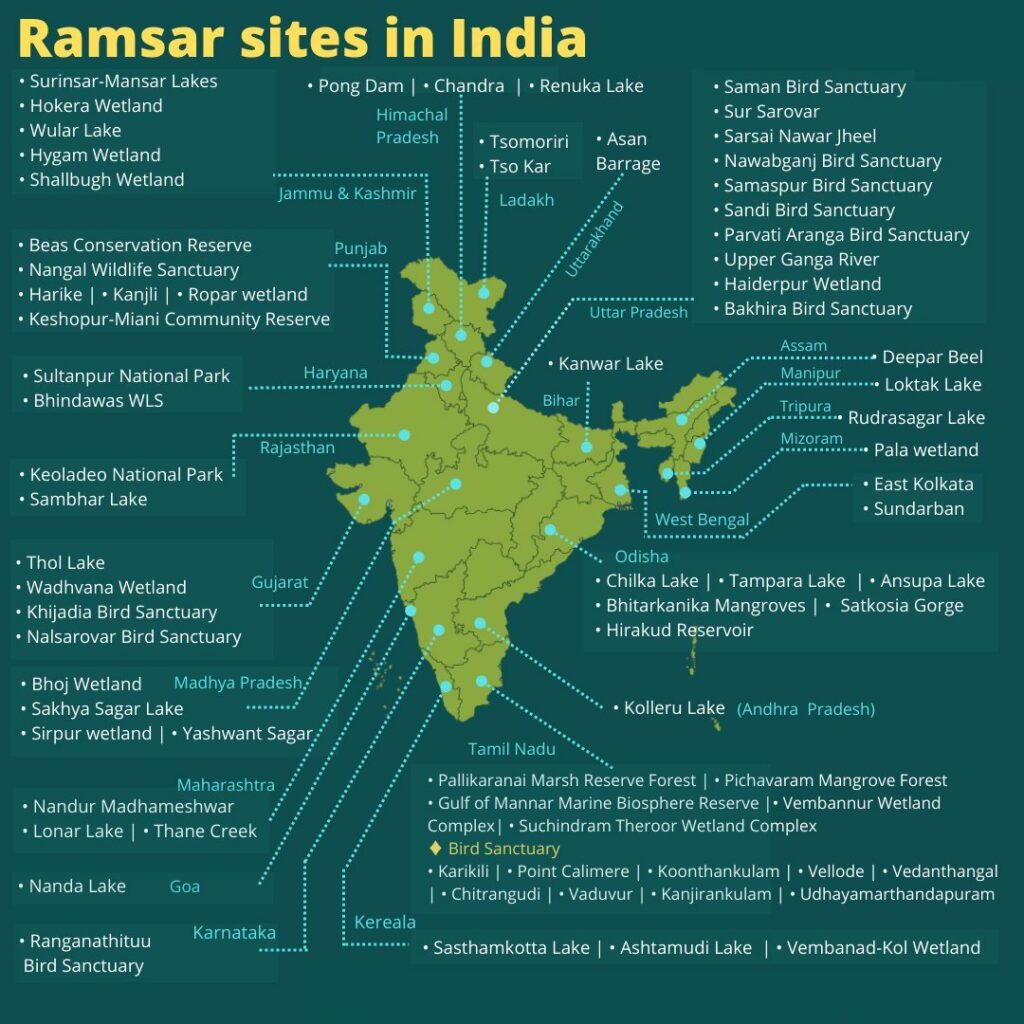
1. Ashtamudi Wetland
- It is a natural backwater in the Kollam district.
- River Kallada and Pallichal drain into it.
- It forms an estuary with Sea at Neendakara (a famous fishing harbor in Kerala).
- National Waterway 3 passes through it.
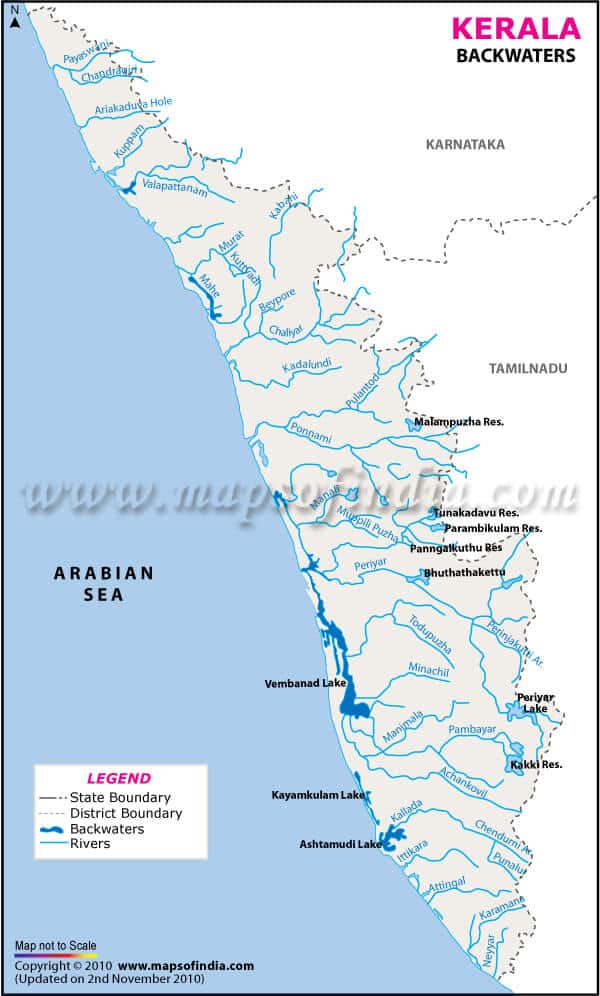
2. Beas Conservation Reserve
- It is a 185-kilometer stretch of the Beas River.
- The stretch is dotted with islands, sand bars, and braided channels.
- The Reserve hosts the only known population in India of the endangered Indus river dolphin.
- In 2017, a program was initiated to re-introduce the critically endangered gharial.
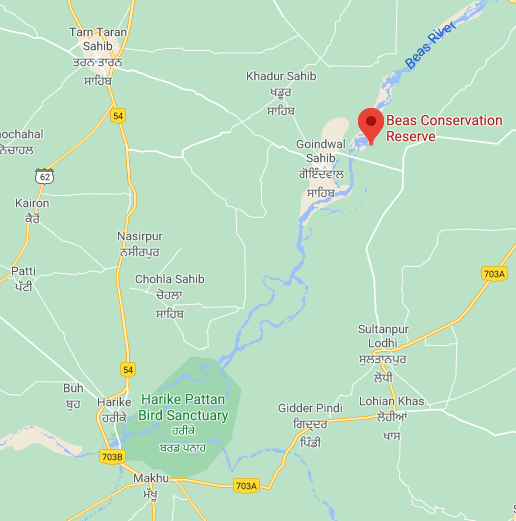
3. Bhitarkanika Mangroves
- It is part of Bhitarkanika Wildlife Sanctuary and designated as Ramsar Wetland of International Importance in 2002.
- Gahirmatha Marine Wildlife Sanctuary is adjacent to the Bhitarkanika Wildlife Sanctuary.
- It is famous for its saltwater crocodiles and Olive ridley sea turtle.
- The core area of Bhitarkanika Wildlife Sanctuary was declared Bhitarkanika National Park.
- Bhitarkanika Wildlife Sanctuary includes Gahirmatha Marine Wildlife Sanctuary.
- Bhitarkanikais located in the estuary of Brahmani, Baitarani, Dhamra& Mahanadi river systems.
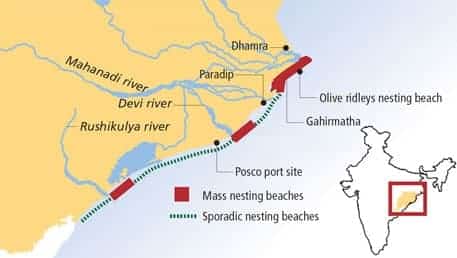
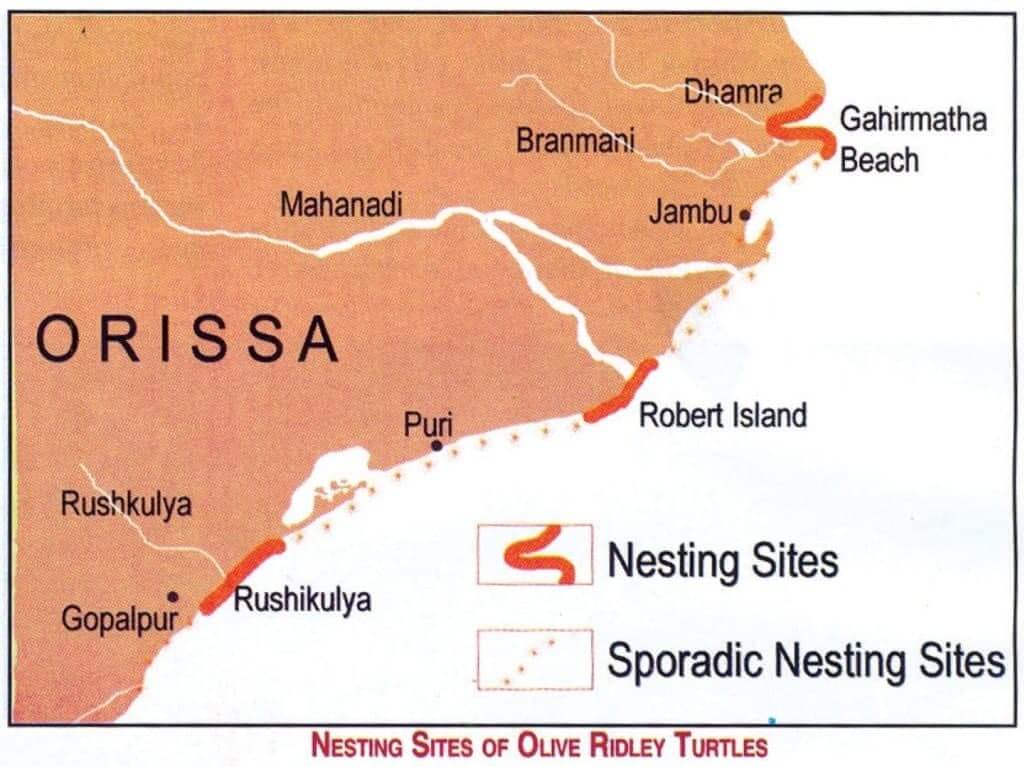
4. Bhoj Wetland
- The Wetland consists of two lakes located in the city of Bhopal.
- The two lakes are the Bhojtal and the Lower Lake.
- It is a humanmade reservoir.
- The largest bird of India, the sarus crane is found here.
5. Chandra Taal
- It is a high-altitude lake. Tso Chikgma or Chandra Taal (meaning the Lake of the Moon), or Chandra Tal is a lake in the Lahaul part of the Lahul and Spiti district of Himachal Pradesh.
- Chandra Taal is near the source of the Chandra River (a source river of the Chenab).
- It supports IUCN Red-listed Snow Leopard.
- Migratory species such as the Ruddy shelduck are found in summer.
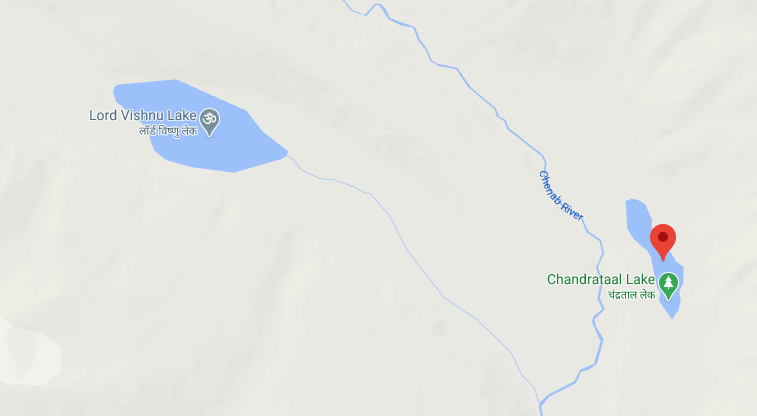
6. Chilika Lake
- It is a brackish water lagoon at the mouth of the Daya River.
- It is the largest coastal lagoon in India.
- Birds from as far as the Caspian Sea, Lake Baikal, Aral Sea, and other remote parts of Central Asia, Ladakh, and the Himalayas come here.
- In 1981, Chilika Lake has designated the first Indian wetland of international importance under the Ramsar Convention.
- Nalbana Bird Sanctuary is the core area of the Ramsar designated wetlands of Chilika Lake.
- The Irrawaddy dolphin (critically endangered) is the flagship species of Chilika lake.
- Chilka is home to the only known population of Irrawaddy dolphins in India.
- Chilika Lake is claimed to have 20% of India’s seagrass distribution, which plays a vital role in oxygen production and absorption of carbon dioxide and acts as a purifier in aquatic ecology.
7. Deepor Beel
- A permanent freshwater lake in a former channel of the Brahmaputra river.
- It is a few kilometers to the left of Guwahati whereas Pobitora Wildlife Sanctuary is around 35 km to the right.

8. East Kolkata Wetlands
- It is multiple use wetland that serves the city of Kolkata.
9. Harike Wetland
- It is a shallow water reservoir at the confluence of the Beas and Sutlej rivers.
- It is an important site for breeding, wintering, and staging birds, supporting over 200,000 Anatidae (ducks, geese, swans, etc.) during migration.
- The Punjab government has planned to introduce amphibious vehicles which can run both on water and land at Harike wetlands.
- Reintroduction of wild gharials in the Beas river area of Harike wetlands.
10. Hokera Wetland
- It is only 10 km from Srinagar.
- It is a natural perennial wetland contiguous to the Jhelum basin.
11. Kanjli Wetland
- Kanjli Wetland, a man-made Wetland, which subsumes the Kanjli Lake, located in the Kapurthala district of Punjab was created by constructing the headworks across the perennial Bien River, a tributary of the Beas River to provide irrigation facilities to the hinterland.
- The stream is considered to be the most significant in the state from the religious point of view, as it is associated with the first guru of the Sikhs, Shri Guru Nanak.
12. Keoladeo National Park
- Formerly known as the Bharatpur Bird Sanctuary
- A complex of ten artificial, seasonal lagoons, varying in size.
- Vegetation is a mosaic of scrub and open grassland that provides habitat for breeding, wintering, and staging migratory birds.
- The invasive growth of the grass Paspalum distichum has changed the ecological character of large areas of the site, reducing its suitability for certain waterbird species, notably the Siberian crane.
- It is also a UNESCO World Heritage site.
13. Keshopur-Miani Community Reserve
- The Site is an example of wise use of a community-managed wetland, which provides food for people and supports local biodiversity.
- Threatened species present include the vulnerable common pochard and the endangered spotted pond turtle.
14. Kolleru Lake
- A naturaleutrophic lake situated between the river basins of the Godavari and the Krishnain Andhra Pradesh.
- The lake serves as a natural flood-balancing reservoir for the two rivers.
- It was previously a lagoon, but now it is several kilometers inland due to the coastline of emergence and delta formation.
- It was notified as a Wildlife Sanctuary in 1999 under India’s Wild Life Protection Act,1972.
- It was declared a wetland of international importance in 2002 under the Ramsar convention.
The Atapaka Bird Sanctuary at Kolleru Lake has become a safe breeding ground for two migratory species namely, Grey Pelicans and Painted Storks.
- The present water level in Kolleru Lake, including Atapaka Sanctuary, is posing a slight challenge for the birds to hunt their prey in the deep waters.
- Grey Pelican and Painted Stork both are near-threatened species under the IUCN Red List of Threatened Species.
Eutrophic water body
- The eutrophic waterbody, commonly a lake or pond, has high biological productivity.
- Due to excessive nutrients, especially nitrogen and phosphorus, these water bodies are able to support an abundance of aquatic plants.
- Usually, the water body will be dominated either by aquatic plants or algae. When aquatic plants dominate, the water tends to be clear. When algae dominate, the water tends to be darker.
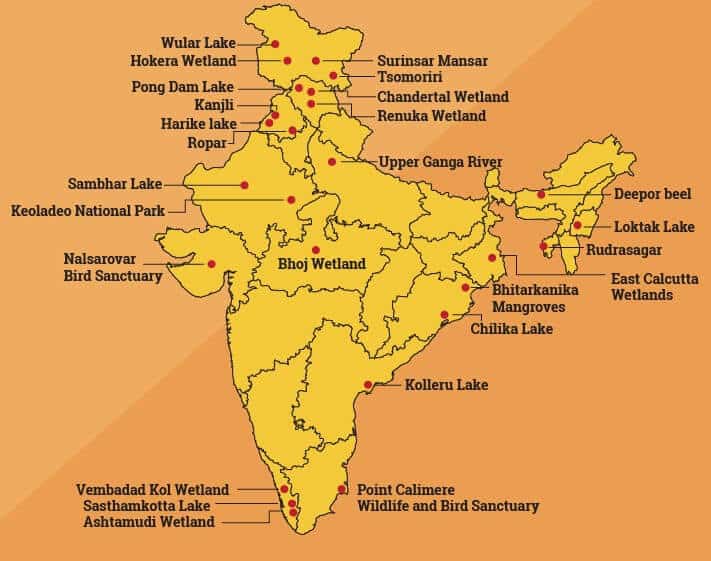
15. Loktak Lake
- Loktak Lake is the largest freshwater lake in the north-eastern region of the country.
- Keibul Lamjao the only floating national park in the world floats over it.
16. Nalsarovar Bird Sanctuary
- A natural freshwater lake (a relict sea) that is the largest natural wetland in the Thar Desert.
- The wetland is a lifeline for a satellite population of the endangered Indian Wild Ass.
17. Nandur Madhameshwar
- Construction of the Nandur Madhameshwar Weir at the confluence of the Godavari and Kadwa Rivers helped create a thriving wetland.
18. Nangal Wildlife Sanctuary
- Located in the Shiwalik foothills of Punjab.
- It supports abundant flora and fauna including threatened species, such as the endangered Indian pangolin and Egyptian vulture.
- It occupies a human-made reservoir constructed as part of the Bhakra-Nangal Project in 1961.
- The site is of historic importance as the Indian and Chinese Prime Ministers formalized the “Five Principles of Peaceful Coexistence” there in 1954.
19. Nawabganj Bird Sanctuary
- It was renamed as Chandra Shekhar Azad Bird Sanctuary in 2015.
20. Parvati Arga Bird Sanctuary
- It is a permanent freshwater environment consisting of two oxbow lakes.
- The Sanctuary is a refuge for some of India’s threatened vulture species: the critically endangered white-rumped vulture and Indian vulture.
21. Point Calimere Wildlife and Bird Sanctuary
- One of the last remnants of Dry Evergreen Forests.
- Habitat: Dry Evergreen Forests, Mangrove & Wetlands.
22. Pong Dam Lake
- It is also known as Maharana Pratap Sagar.
- Pong Dam Lake is a water storage reservoir created in 1975 on the Beas River in the low foothills of the Himalaya on the northern edge of the Indo-Gangetic plain.
- The avian habitats formed by the creation of the Pong Dam assume great significance – given the site’s location on the trans-Himalayan flyway, more than 220 bird species have been identified, with 54 species of waterfowl.
- Fauna: Barking deer, sambar, wild boars, nilgai, leopards, and oriental small-clawed otters.
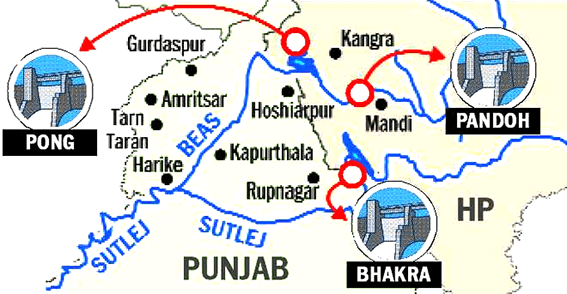
23. Renuka Lake
- A natural wetland with freshwater springs and inland subterranean karst formations.
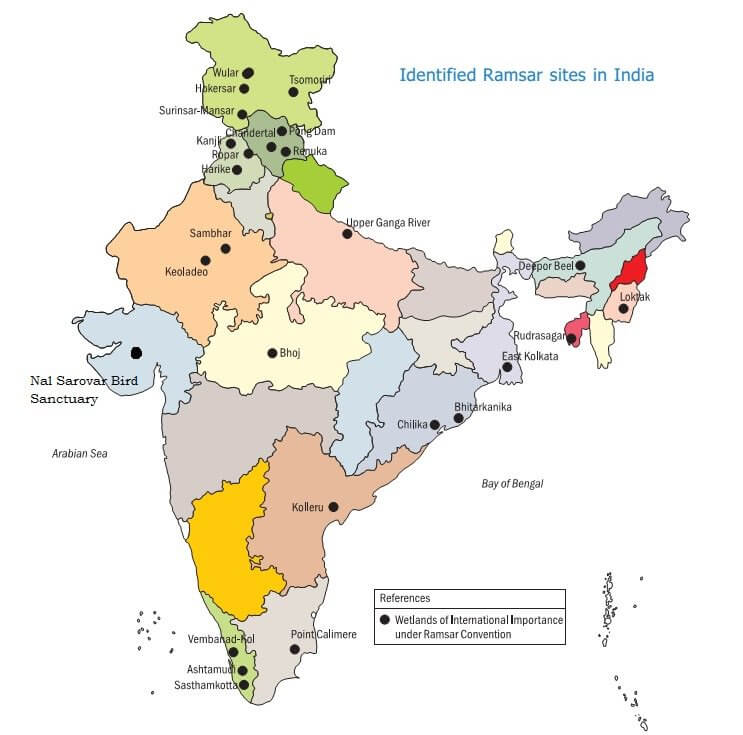
24. Ropar Wetland
- A human-made wetland of lake and river formed by the construction of a barrage for diversion of water from the Sutlej River.
25. Rudrasagar Lake
- It is a reservoir fed by three perennial streams discharging to the River Gomti.
- It is an ideal habitat for IUCN Red-listed Three-striped Roof Turtle.
26. Saman Bird Sanctuary
- It is a seasonal oxbow lake on the Ganges floodplain.
27. Samaspur Bird Sanctuary
- It is a perennial lowland marsh typical of the Indo-Gangetic Plains.
- The Sanctuary harbours threatened species such as the endangered Egyptian vulture.
28. Sambhar Lake
- The Sambhar Salt Lake is India’s largest inland saltwater lake.
- It is a key wintering area for tens of thousands of flamingos.
29. Sandi Bird Sanctuary
- The wetland is typical of the Indo-Gangetic plains.
30. Sarsai Nawar Jheel
- It is a permanent marsh.
- It is an example of co-habitation of humans and wildlife.
- The site’s name is derived from the large non-migratory sarus crane.
31. Sasthamkotta Lake
- It is the largest freshwater lake in Kerala, situated in Kollam district.
- River Kallada had a unique replenishing system through a bar of paddy field.
- The lake is now depleting due to destruction of replenishing mechanism.
32. Sundarban Wetland
- Sundarban Wetland is located within the largest mangrove forest in the world.
- It is the largest Ramsar Site in India.
- The Indian Sundarban, covering the south-westernmost part of the delta, constitutes over 60% of the country’s total mangrove forest area and includes 90% of Indian mangrove species.
33. Surinsar-Mansar Lakes
- Freshwater composite lake in semi-arid Panjab Plains, adjoining the Jhelum Basin.
34. Tsomoriri (Tso Moriri)
- Tso Moriri or Lake Moriri or “Mountain Lake”, is a lake in the Changthang Plateau (literally: northern plains) in Ladakh
- Changpa Tribes or Champa are semi-nomadic Tibetan people found mainly in the Changtang in Ladakh and in Jammu and Kashmir.
- A freshwater to brackish lake lying at 4,595m above sea level.
- The site is said to represent the only breeding ground outside of China for one of the most endangered cranes, the Black-necked crane, and the only breeding ground for Bar-headed geese in India.
- The Great Tibetan Sheep or Argali and Tibetan Wild Ass are endemic to the region.
- With no outflow, evaporation in the arid steppe conditions causes varying levels of salinity.
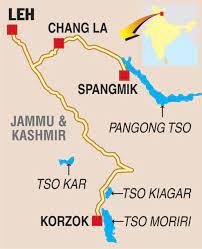
35. Upper Ganga River (Brijghat to Narora Stretch)
- The river provides habitat for IUCN Red listed Ganges River Dolphin and Gharial Crocodile.
36. Vembanad-Kol Wetland
- The largest lake of Kerala, spanning across Alappuzha, Kottayam, and Ernakulam districts.
- It is the second-largest Ramsar Site in India after Sundarbans.
- It is also the longest lake in India.
- It is below sea level and is famous for exotic fish varieties and Paddy fields that are below sea level.
- The ‘Kumarakom Bird Sanctuary’ is located on the east coast of the lake.
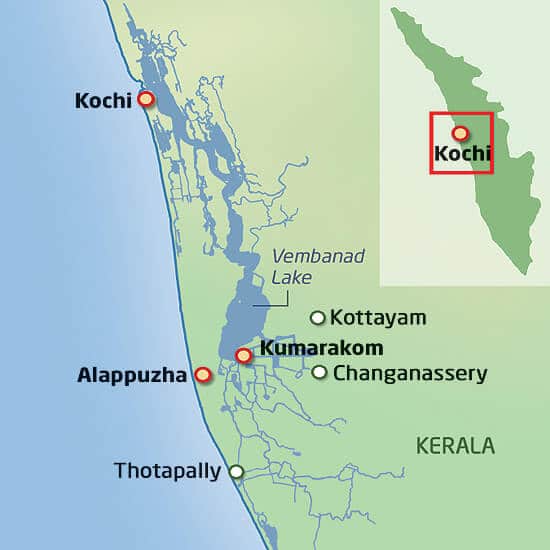
37. Wular Lake
- It is the largest freshwater lake in India.
- The lake basin was formed as a result of tectonic activity and is fed by the Jhelum River.
- The Tulbul Project is a “navigation lock-cum-control structure” at the mouth of Wular Lake.
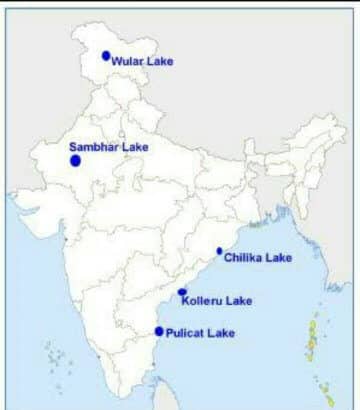
38. Asan Conservation Reserve
- ACR is a 444-hectare stretch of the Asan River running down to its confluence with theYamuna River in the Dehradun district of Uttarakhand. It is Uttarakhand’s first Ramsar Site.
- The damming of the River by the Asan Barrage in 1967 resulted in siltation above the dam wall, which helped to create some of the Site’s bird-friendly habitats.
- These habitats support 330 species of birds including the critically endangered red-headed vulture (Sarcogyps calvus), white-rumped vulture (Gyps bengalensis), and Baer’s pochard (Aythya baeri).
- Other non-avian species present include 49 fish species, one of these being the endangered Putitora mahseer (Tor putitora). Fish use the site for feeding, migration, and spawning.
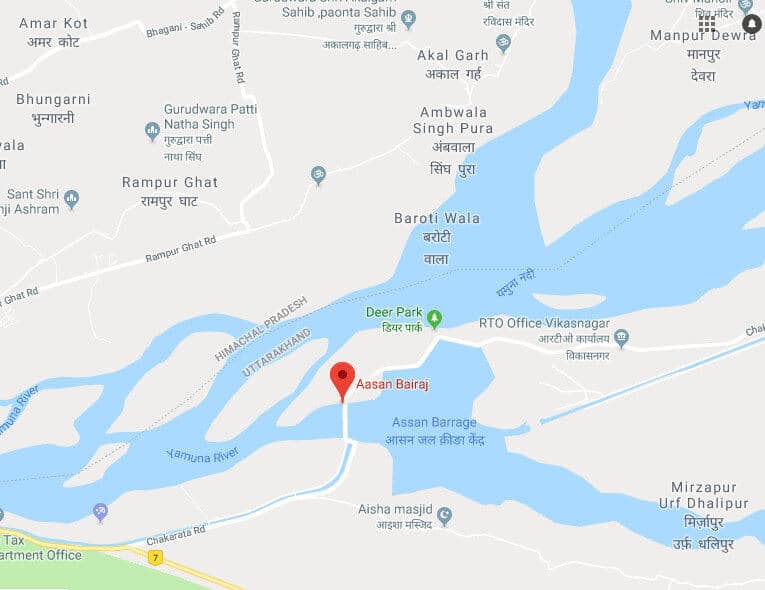
39. Kabartal Wetland
- Also known as Kanwar Jheel, it covers 2,620 hectares of the Indo-Gangetic plains in the Begusarai district of Bihar.
- It acts as a vital flood buffer for the region besides providing livelihood opportunities to local communities.
- Significant biodiversity is present, with 165 plant species and 394 animal species recorded, including 221 bird species. It is also a valuable site for fish biodiversity with over 50 species documented.
- It is an important stopover along the Central Asian Flyway, with 58 migratory waterbirds using it to rest and refuel.
- Five critically endangered species inhabit the site, including three vultures – the red-headed vulture (Sarcogyps calvus), white-rumped vulture (Gyps bengalensis) and Indian vulture (Gyps indicus) – and two waterbirds, the sociable lapwing (Vanellus gregarius) and Baer’s pochard (Aythya baeri).
- Major threats to the Site include water management activities such as drainage, water abstraction, damming and canalization.
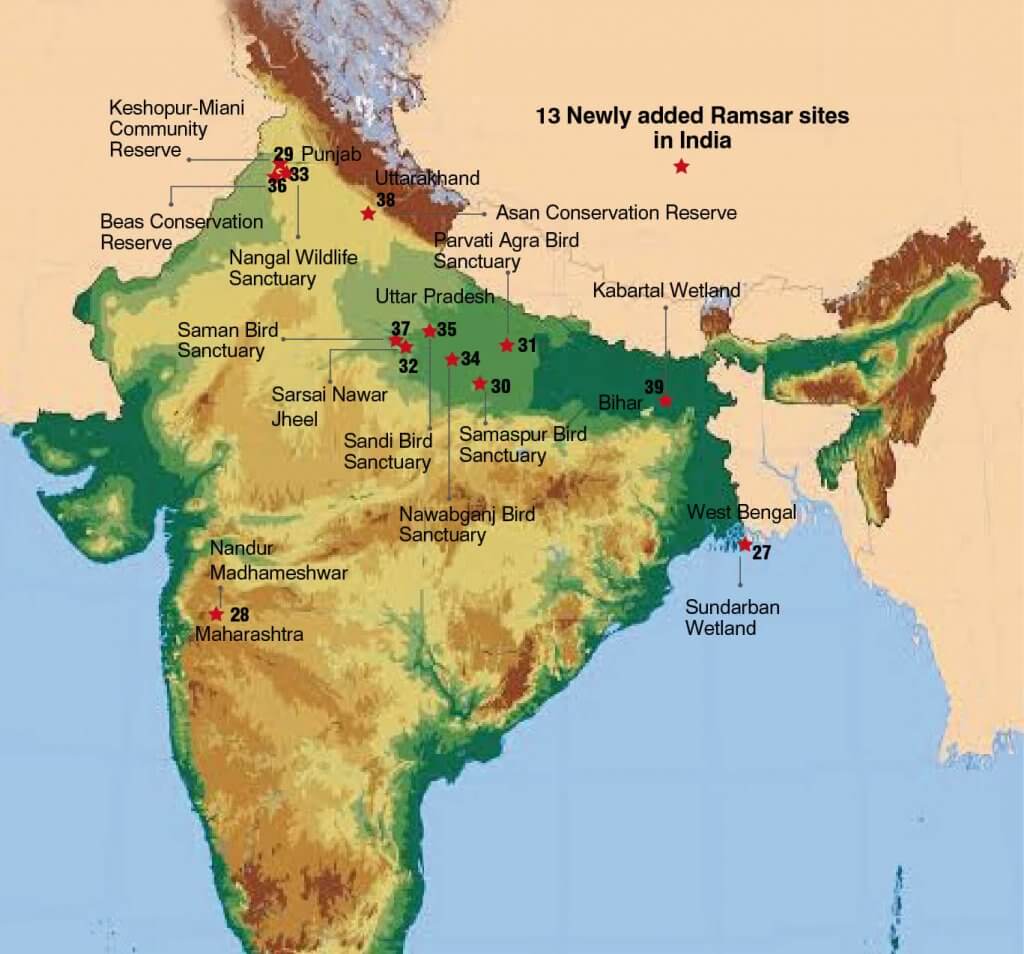
- It is also known as Keetham lake situated within the Soor Sarovar Bird Sanctuary, which was declared as a bird sanctuary in the year 1991.
- Location:
- This lake is situated alongside the river Yamuna in Agra, Uttar Pradesh.
- The Soor Sarovar bird sanctuary covered an area of 7.97 sq km.
- It is today home to more than 165 species of migratory and resident birds.
- It also has a Bear Rescue center for rescued dancing bears.
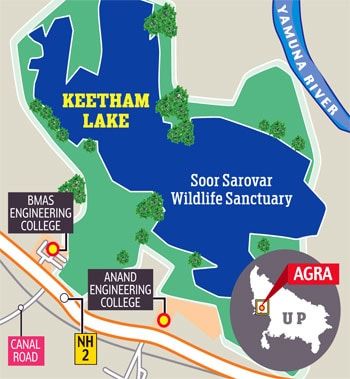
- The Lonar lake, situated in the Deccan Plateau’s volcanic basalt rock, was created by the impact of a meteor 35,000 to 50,000 years ago.
- The lake is part of Lonar Wildlife Sanctuary which falls under the unified control of the Melghat Tiger Reserve (MTR).
- It is also known as a Lonar crater and is a notified National Geo-heritage Monument. Geo-heritage refers to the geological features which are inherently or culturally significant offering insight to earth’s evolution or history to earth science or that can be utilized for education.
- It is the second Ramsar site in Maharashtra after Nandur Madhmeshwar Bird Sanctuary in the Nashik district.
- The water in the lake is highly saline and alkaline, containing special microorganisms like anaerobes, Cyanobacteria, and phytoplankton.
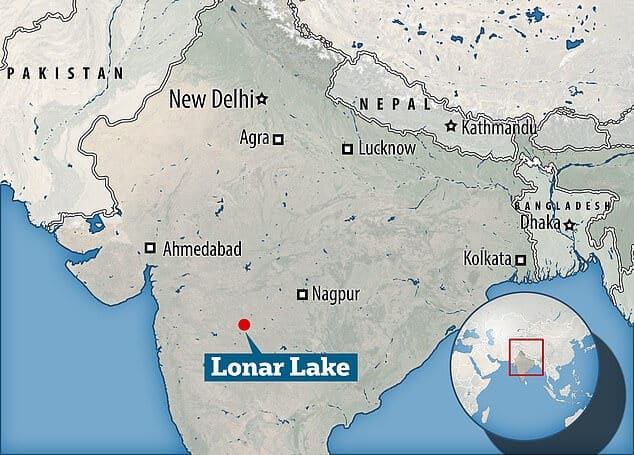
42. Tso Kar Wetland Complex (Tso Kar Lake)
- Ladakh’s Tso Kar Wetland Complex has been recognized as a wetland of international importance, becoming India’s 42nd Ramsar site. This is the second Ramsar site in the Union Territory of Ladakh. It is a high-altitude wetland complex, found at more than 4,500 meters above sea level in the Changthang region of Ladakh.
- The Tso Kar Basin is a high-altitude wetland complex, which comprises two principal waterbodies– Startsapuk Tso and Tso Kar Lake situated in Ladakh’s Changthang region.
- Startsapuk Tso is a freshwater lake and Tso Kar is a hypersaline lake.
- The TSO Kar name means white lake and it was given because of the white salt efflorescence found on the margins of the wetlands due to the evaporation of highly saline water.
- The TSO Kar basin is categorized as A1 Category Important Bird Area (IBA) as per BirdLife International and is also a key staging site in the Central Asian Flyway.
- The basin is one of the most important breeding areas of the Black-necked Crane (Grus nigricollis) in India.
- It is also a major breeding area for the Bar-headed Geese (Anserindicus), Great Crested Grebe (Podicepscristatus), Ruddy Shelduck (Tadornaferruginea), Lesser Sand-Plover (Charadriusmongolus) and Brown-headed Gull (Larusbrunnicephalus), and many other species.
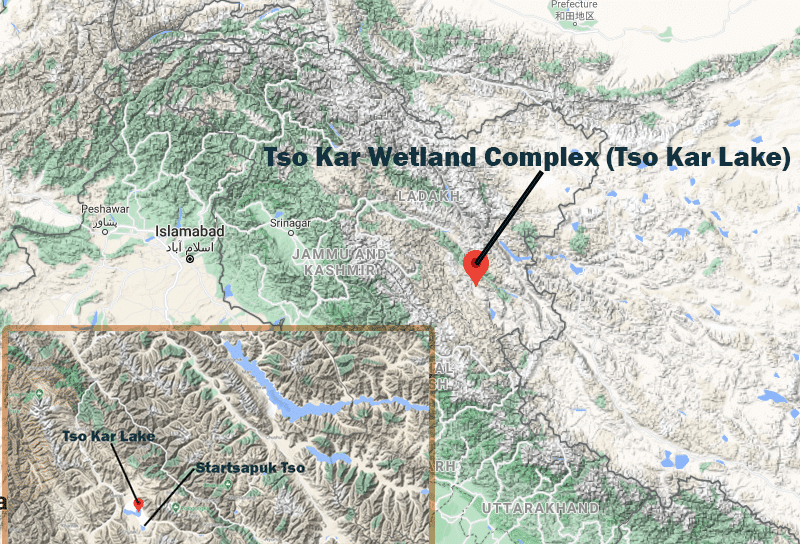
43. Sultanpur National Park, Haryana
- Sultanpur National Park (formerly Sultanpur Bird Sanctuary) is located at Sultanpur village on Gurugram-Jhajjar highway, 15 km from Gurugram, Haryana, and 50 km from Delhi in India.
- More than 10 globally threatened, including the critically endangered sociable lapwing, and the endangered Egyptian Vulture, Saker Falcon, Pallas’s Fish Eagle, and Black-bellied Tern birds are found here.
- It is essentially a bird watcher’s paradise.
44. Bhindawas Wildlife Sanctuary
- It is a human-made freshwater wetland, located in Jhajjar district, Haryana.
- It is an important part of the ecological corridor along the route of Sahibi River which traverses from Aravalli hills in Rajasthan to the Yamuna.
- It shares its border with Khaparwas Wildlife Sanctuary (Haryana).
45. Thol Lake
- It is located in the Mehsana district of Gujarat. It is a shallow freshwater reservoir and a predominantly open water area. It is a man-made wetland.
- It lies on the Central Asian Flyway and more than 320 bird species can be found here.
- The wetland supports more than 30 threatened waterbird species, such as the critically endangered White-rumped Vulture and Sociable Lapwing, and the vulnerable Sarus Crane, Common Pochard, and Lesser White-fronted Goose.
46. Wadhvana Wetland
- It is located in Dabhoi Tehsil (Taluka), Vadodara district, Gujarat.
- River Orsang (which joins with the Narmada River at Chandod) flows into the lake.
- The red-crested pochard (Netta rufina), a duck that is otherwise rare in Western India, is regularly recorded here during winter.
- It is internationally important for its birdlife as it provides wintering ground to migratory waterbirds, including over 80 species that migrate on the Central Asian Flyway.
47. Haiderpur Wetland
- The Haiderpur Wetland is spread over an area of 6908 hectares on the Muzaffarnagar-Bijnor border between the Ganges and the Solani River.
- It is a part of Hastinapur Wildlife Sanctuary.
- Haiderpur Wetland is a man-made lake, which was formed in 1984. The biodiversity here attracts birds. Exotic birds reach here by crossing the hills of Mongolia.
- Also there are many species of dolphins, turtles, alligators, crocodiles, butterflies and deer etc. There are over 30 plant species and over 300 bird species, as well as over 40 fish species and over 102 waterfowl species.
48. Khijadia Wildlife Sanctuary
- Khijadiya Bird Sanctuary (KBS) is a unique wetland ecosystem located in Jamnagar district on the southern coast of the Gulf of Kutch, of Gujarat state.
- Khijadiya Bird Sanctuary (KBS) is one of the Important Bird Area (IBA) from Gujarat state.
- Khijadiya Wildlife Sanctuary joins with Marine National Park on one side and on the other Dhunvav river empties fresh water in it.
- The sanctuary is having a unique habitat with fresh water on one side and salt pans on another side.
- Also, on the northern side is a large creek that flows from the Gulf of Kutch. This supports mangroves and marine diversity.
- There are two freshwater lakes (reclamation dam) located in the Sanctuary.
- Many migratory birds stop here during the winter.
- This sanctuary provides a nesting and breeding ground for migratory birds.
- The sanctuary is located at the watershed of Ruparel and Kalindri river at the North East coastal region of Jamnagar district in the Gulf of Kutch.
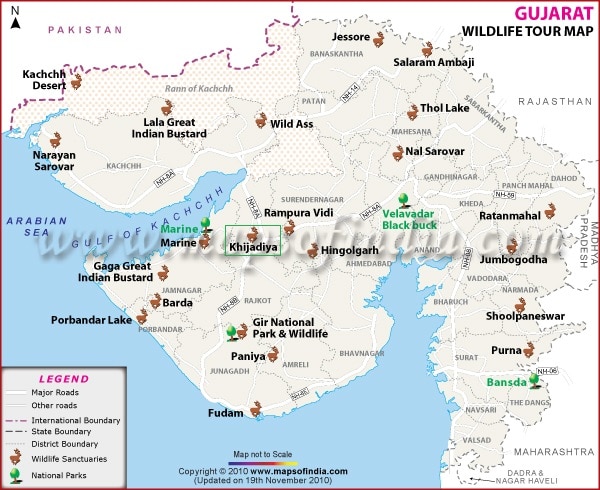
49. Bakhira Wildlife Sanctuary
- The Bakhira Bird Sanctuary is the largest natural flood plain wetland of India in Sant Kabir Nagar district of Eastern Uttar Pradesh.
- The sanctuary was established in 1980. It is situated 44 km west of Gorakhpur city.
- Bakhira bird sanctuary also known as Bakhira Tal, located to the west of the Rapti riverbank, is a shallow-water, river-connecting wetland.
- Bakhira Tal (wetland) is the largest natural wetland of Eastern U.P. It is a perennial wetland, where the source of water is natural rain and the Ami River, a tributary of the Rapti River.
- Apart from birds, the Sanctuary has a variety of trees, shrubs, hydrophytes.
- About 40,000 birds belonging to about 30 species have been recorded during winters.
- It is a vast stretch of water body expanding over an area of 29 sq. km.
- The landscape and terrain of the wetland is almost flat, representing a typical ‘Terai’ landscape.
- The sanctuary is named after the village Bakhira located adjacent to the lake.
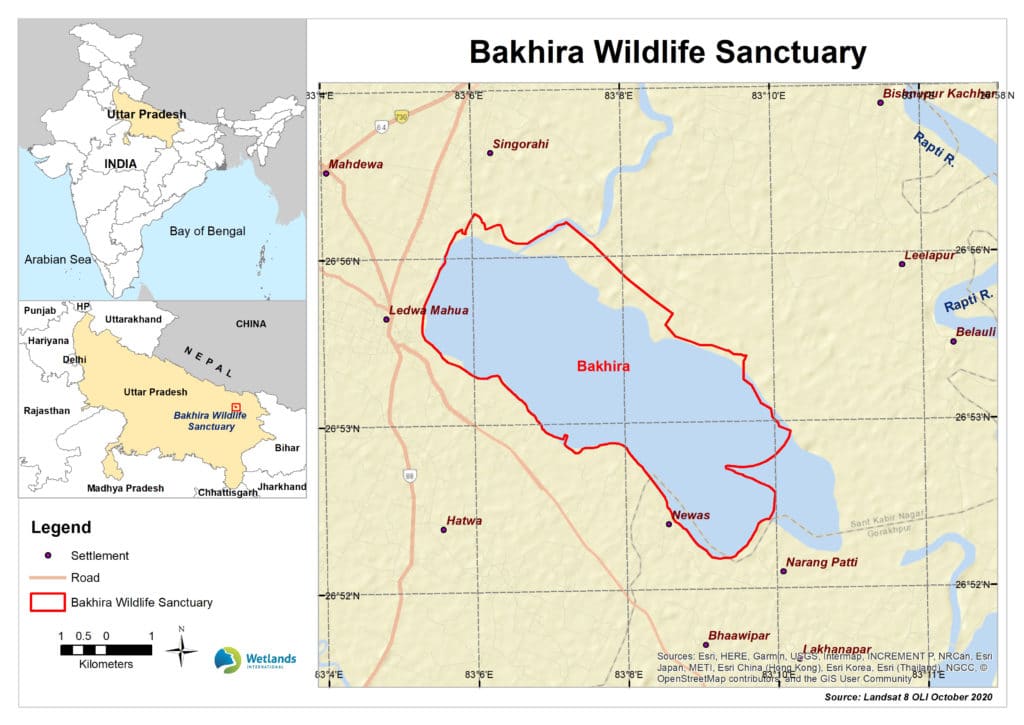
50. Karikili Bird Sanctuary (Tamil Nadu)
- The sanctuary is spread over a five-kilometer-wide belt and is home to cormorants, egrets, grey heron, open-billed stork, darter, spoonbill, white lbis, night herons, grebes, grey pelican among others.
51. Pallikaranai Marsh Reserve Forest (Tamil Nadu)
- One of the last remaining natural wetlands, the marsh drains in an area of 250 square kilometres encompassing 65 wetlands.
- The Pallikaranai Marsh is one of the few natural coastal aquatic habitats that qualify as a wetland in India.
52. Pichavaram Mangrove (Tamil Nadu)
- One of the last mangrove forests in the country.
- It has an island of a vast expanse of water covered with mangrove forests.
53. Sakhya Sagar (Madhya Pradesh)
- Created from the Manier river in 1918, Sakhya Sagar is located near Madhav National Park.
54. Pala Wetland in Mizoram (Mizoram)
- It is home to a wide range of animals, birds, and reptiles.
- Its geographical location falls under the Indo-Burma biodiversity hotspot and is therefore rich in animal and plant species.
- The lake is a major component of the Palak Wildlife Sanctuary and it supports the major biodiversity of the sanctuary.
55. Koothankulam Bird Sanctuary
- It adjoins the tiny village of Koonthankulam in Nanguneri Taluk of Tirunelveli district, Tamil Nadu.
- It is an Important Bird and Biodiversity Area (IBA) on the Central Asian Flyway. This is the largest reserve for breeding water birds in South India.
56. Gulf of Mannar Marine Biosphere Reserve
- The Gulf of Mannar is a large shallow bay forming part of the Laccadive Sea in the Indian Ocean with an average depth of 5.8 m. It lies between the southeastern tip of India and the west coast of Sri Lanka, in the Coromandel Coast region.
- Gulf of Mannar is one of the biologically richest coastal regions in all of the mainland of India. It is the first Marine Biosphere Reserve in South and South East Asia.
- In India, the Gulf of Mannar region in Tamil Nadu is one of the four major coral reef areas and the others are Gulf of Kutch in Gujarat, Lakhsadweep and Andaman and Nicobar islands.
- The Gulf of Mannar includes three distinct Coastal ecosystems. Those three ecosystems are coral reef, seagrass bed, and mangroves (world’s richest region from a marine biodiversity perspective), which is a storehouse of marine diversity of global significance and is known for its unique biological wealth.
57. Vembannur Wetland Complex
- Vembannur Wetland Complex is a man-made inland tank which forms the southernmost tip of peninsular India.
- This wetland forms part of the Important Bird and Biodiversity Area and hence part of the BirdLife International Data Zone.
58. Vellode Bird Sanctuary
- Vellode Birds Sanctuary is an 80 ha sanctuary located in the Erode District in the state of Tamil Nadu.
- This human-made tank is an ideal habitat for birds, due to the abundant food resources it provides from neighbouring agricultural fields, and other aquatic organisms.
59. Vedanthangal Bird Sanctuary
- Vedanthangal Bird Sanctuary is a 30-hectare protected area located in the Madurantakam taluk of the Chengalpattu District in the state of Tamil Nadu.
- The sanctuary is about 75 kilometers from Chennai on National Highway 45.
- Vedanthangal is home to migratory birds such as pintail, garganey, grey wagtail, blue-winged teal, common sandpiper, and the like.
- Vedanthangal is the oldest water bird sanctuary in the country.
- Vedanthangal in Tamil language means ‘hamlet of the hunter’.
60. Udhayamarthandapuram Bird Sanctuary
- Udayamarthandapuram Bird Sanctuary is a protected area in Tiruvarur District, Tamil Nadu.
- A notable aspect of the sanctuary is a large number of purple moorhen and openbill storks during February and March.
- The Sanctuary consists of human-made irrigation tanks, interconnected by an ancient network of canals and fed by the Mettur dam through the Koraiyar canal.
61. Satkosia Gorge (Odisha)
- Satkosia Gorge is a gorge in eastern Odisha, carved by the Mahanadi River.
- The gorge is located within the Satkosia Tiger Reserve which is a United Nations Protected area.
62. Nanda Lake (Goa)
- Nanda Lake comprises intermittent freshwater marshes that lie adjacent to one of the major tributaries of the Zuari River.
- They are linked to the adjacent river channel by a sluice gate, which when closed enables the flooding of the marshes.
- This wetland supports a wide variety of migratory waterbirds and many other important plants and animals.
- Notable bird species include black-headed ibis, common kingfisher, wire-tailed swallow, bronze-winged jacana, brahminy kite, intermediate egret, little cormorant, and lesser whistling duck.
- The Site enables local communities to store water during the off-monsoon season, to cultivate rice paddies downstream of the lake, and support fishing and recreation. The lake also protects downstream areas from monsoon floods.
- Threats include invasive non-native species, garbage, and solid waste, overfishing, and harvesting of aquatic resources.
63. Ranganathittu Bird Sanctuary(Karnataka)
- Ranganthittu Bird Sanctuary is a part of the Kaveri River on the Southern Deccan Plateau.
- This region comprises gently rolling plains traversed by several of the large rivers that rise in the Western Ghats mountain range and flow eastward to the Bay of Bengal.
- The Site is an ecologically important riverine wetland, rich in plant and animal species.
- It supports healthy populations of mugger crocodile, smooth-coated otter, and hump-backed mahseer.
- The Site also supports over 1% of the global population of a painted stork, spot-billed pelican, and black-headed ibis and as such it is classified as an Important Bird and Biodiversity Area (IBA).
- The Site is classified as an Eco-Sensitive Zone and a management plan is currently being implemented to safeguard its ecological integrity as well as the ecosystem services provided to the local communities.
64. Sirpur Wetland (Madhya Pradesh)
- Sirpur Wetland is a human-made wetland that has stabilized and acquired near-natural characteristics in the last two centuries.
- Sirpur Lake is located on Indore-Dhar Road in Indore.
- the Site is a shallow, alkaline, nutrient-rich lake that floods during the monsoon to a maximum depth of two metres.
65. Tampara Lake
- Tampara Lake is among the most prominent freshwater lakes in the State of Odisha situated in Ganjam district.
- The depression on the ground gradually filled with rainwater from catchment flow and was called “Tamp” by the British and subsequently termed “Tampra” by the locals.
- The wetland is an important habitat for vulnerable species such as Cyprinus carpio, common pochard (Aythya ferina), and river tern (Sterna aurantia).
66. Hirakud Reservoir
- Hirakud Reservoir, the largest earthen dam in Odisha started operating in 1957.
- The reservoir is a source of water for producing around 300 MW of hydropower and irrigating 436,000 ha of cultural command area.
- The wetland also provides important hydrological services by moderating floods in the Mahanadi delta, the ecological and socio-economic hub of the east coast of India.
67. Ansupa Lake
- Ansupa Lake is the largest freshwater lake of Odisha situated in Banki sub-division of Cuttack district and has its fame from time immemorial for its scenic beauty, biodiversity, and natural resources.
- The wetland is an oxbow lake formed by River Mahanadi and is spread over an area of 231 ha.
- The wetland provides a safe habitat to at least three threatened bird species- Rynchops albicollis (EN), Sterna acuticauda (EN) and Sterna aurantia (VU) and three threatened fish species- Clarias magur (Clariidae) (EN), Cyprinus carpio (Cyprinidae) (VU) and Wallago attu (VU).
68. Yashwant Sagar
- Yashwant Sagar is one of the two Important Bird Areas (IBA) in the Indore region as well as one of the most important birding sites in Malwa region of Madhya Pradesh.
- Presently it is mainly used for water supply to the city of Indore and is also being used for fish culture on a commercial scale.
- The catchment area of this wetland is predominantly agriculture.
- Yashwant Sagar is considered to be a stronghold of the vulnerable Sarus Crane in central India. The lake backwaters have plenty of shallow areas, conducive for waders and other waterfowl.
69. Chitrangudi Bird Sanctuary
- Chitrangudi Bird Sanctuary, locally known as “Chitrangudi Kanmoli” is located in Ramanathapuram district in Tamil Nadu.
- The wetland is a protected area since 1989 and declared as Bird Sanctuary, coming under the jurisdiction of Tamil Nadu Forest Department, Ramanathapuram division.
- Chitrangudi Bird Sanctuary is an ideal habitat for winter migratory birds. Chitrangudi is surrounded by agricultural fields, where different crops are grown throughout the year.
70. Suchindram Theroor Wetland Complex
- Suchindrum Theroor Wetland complex is part of the Suchindrum-Theroor Manakudi Conservation Reserve.
- It is declared an Important Bird Area and lies at the southern tip of the Central Asian flyway of migratory birds. It was formed for birds’ nesting purposes and it attracts thousands of birds every year.
- Copper plate inscriptions from the 9th century mention Pasumkulam, Venchikulam, Nedumarthukulam, Perumkulam, Elemchikulam and Konadunkulam.
71. Vaduvur Bird Sanctuary
- Vaduvur bird sanctuary spreads over an area of 112.638 ha, is a large human-made irrigation tank and shelter for migratory birds as it provides a suitable environment for food, shelter, and breeding ground.
72. Kanjirankulam Bird Sanctuary
- Kanjirankulam Bird Sanctuary is a Protected area near Mudukulathur Ramanathapuram District, Tamil Nadu India, declared in 1989.
- It is notable as a nesting site for several migratory heron species that roost in the prominent growth of babul trees there.
- The breeding population of migratory waterbirds arrive here between October and February and include: painted stork, white ibis, black ibis, little egret, great egret.
- The site qualifies as an IBA as the threatened Spot-billed Pelican Pelecanus philippensis breeds here.
- The wetland exhibits rich biodiversity including many globally near-threatened species like Spot-billed Pelican, Oriental Darter, Oriental white Ibis and Painted Stork and also commonly occurring shore and water birds like greenshank, plovers, stilts and forest birds like bee-eaters, bulbuls, cuckoos, starlings, barbets, etc.
- They act as breeding, nesting, roosting, foraging, and stopover sites for the birds.
- The wetland supports IUCN RedList vulnerable avian species like Sterna aurantia (River Tern).
73. Thane Creek
- Thane Creek is located in Maharashtra, India.
- There are several sources of fresh water to the creek, of which Ulhas River is the largest, followed by many drainage channels from various suburban areas of Mumbai, Navi Mumbai & Thane.
- It has been declared as Thane Creek Flamingo Sanctuary.
- Thane creek is fringed by mangroves on both banks & comprises around 20% of the total Indian mangrove species.
- The area is an important part of the wetland complex of the Central Asian Flyway of the birds and has been categorized as an Important Bird Area (IBA).
74. Hygam Wetland Conservation Reserve
- Hygam Wetland falls within the River Jhelum basin and plays a significant role as a flood absorption basin, biodiversity conservation site, eco-tourism site, and livelihood security for the local communities.
- The wetland is located in the Baramulla district.
- It serves as an abode to many residents and migratory bird species. It is also recognized as an Important Bird Area (IBA).
- Consequent to the high rate of siltation, Hygam Wetland has lost its wetland characteristics to a large extent and in many places changed its profile into a landmass.
75. Shallbugh Wetland Conservation Reserve
- Shallabug Wetland Conservation Reserve is located in the District Srinagar, UT of J&K.
- Large areas of the wetland dry up between September and March.
- The area has extensive reedbeds of Phragmites communis and Typha angustata, and rich growth of Nymphaea candida and N. stellata on open water.
- It serves as an abode to more than four lakh resident and migratory birds of at least 21 species.
76. Ankasamudra Bird Conservation Reserve (Karnataka)
- The Site is a human-made wetland built for storing monsoon run-off water coming from the Tungabhadra River and providing irrigation to surrounding drought-risk areas.
- At least 20% of the regional population of glossy ibis has been regularly recorded at the Site.
- There are also nine endemic fish species, three of which are globally endangered: tiger loach (Botia striata), aruli barb (Dawkinsia arulius) and nukta (Schismatorhynchos nukta).
- Excessive growth of the invasive alligator weed, the shrub Prosopis juliflora and the African catfish are threatening the native fish and waterbirds.
77. Aghanashini Estuary (Karnataka)
- It is spread over an area of 4801 ha, and is formed at the confluence of the Aghanashini River with the Arabian Sea.
- The brackish water of the estuary provides diverse ecosystem services including flood and erosion risk mitigation, biodiversity conservation and livelihood support.
- The wetland also provides livelihoods by supporting fishing, agriculture, collection of edible bivalves and crabs, shrimp aquaculture, traditional fish farming in the estuarine rice fields (locally known as Gazni rice fields) and salt production.
- In the estuary, farmers practice traditional farming to grow a salt-tolerant rice called “kagga”, which is one of the specialities of the region.
- The mangroves bordering the estuary help to protect the shores against storms and cyclones.
78. Magadi Kere Conservation Reserve (Karnataka)
- It is a human-made wetland with an area of nearly 50 hectares which was constructed to store rainwater for irrigation purposes.
- The wetland harbors two vulnerable species, namely Common pochard and River tern and four near-threatened species namely Oriental Darter, Black-headed Ibis, Woolly- necked Stork and Painted Stork.
- It is also one of the largest wintering grounds for the Bar-headed goose in Southern India. It has been declared globally as an Important Bird and Biodiversity Area (IBA).
79. Karaivetti Bird Sanctuary (Tamil Nadu)
- The Karaivetti Bird Sanctuary is a protected area and Ramsar site, located in the Ariyalur District of Tamil Nadu.
- The sanctuary is a large irrigation tank located in the northern alluvial plains of the Kaveri river.
- This freshwater lake is fed by Pullambadi, Kattalal canal and attracts thousands of birds every year.
- Water from the wetland is utilized by the villagers for cultivating agricultural crops such as paddy, sugar cane, cotton, corn, and split red gram.
- About 198 species of birds have been recorded here; some of the important visitors being the Bar headed Goose, Pin-tailed duck, Garganey, Northern Shoveler, Common Pochard, Eurasian Wigeon, Common teal and Cotton teal.
80. Longwood Shola Reserve Forest (Tamil Nadu)
- It derives its name from the Tamil word, “Solai”, which means a ‘tropical rainforest’.
- The ‘Sholas’ are found in the upper reaches of the Nilgiris, Anamalais, Palni hills, Kalakadu, Mundanthurai and Kanyakumari in Tamil Nadu.
- These forested wetlands serve as habitats for the globally endangered Black-chinned Nilgiri Laughing thrush, Nilgiri Blue Robin, and vulnerable Nilgiri Wood-pigeon.
- Longwood Shola Reserve Forest is one of the Important Bird Areas (IBA’s) of Tamil Nadu.
- It is mainly threatened by encroachment, invasive species and deforestation.
Criteria for Identification of Wetlands under Ramsar Convention
If a wetland –
- contains a representative, rare, or unique example of a natural or near-natural wetland type.
- supports vulnerable, endangered, or critically endangered species; or threatened ecological communities.
- supports populations of plant and/or animal species important for maintaining the biological diversity of a particular biogeographic region.
- supports plant and/or animal species at a critical stage in their life cycles or provides refuge during adverse conditions.
- regularly supports 20,000 or more water birds.
- regularly supports 1% of the individuals in a population of one species or subspecies of water birds.
- supports a significant proportion of indigenous fish subspecies
- is an important source of food for fishes, spawning ground, nursery and/or migration path.
- is an important source of food and water resource, increased possibilities for recreation and eco-tourism, etc.
Wetlands International
- Wetlands International is a global organization (NGO) that works to sustain and restore wetlands and their resources for people and biodiversity.
- Wetlands International’s work ranges from research, advocacy, and engagement with governments, corporate and international policy fora, and conventions.
National Wetlands Conservation Programme (NWCP)
- NWCP was implemented in the year 1985-86.
- Under the programme, 115 wetlands have been identified by the MoEF which require urgent conservation and management interventions.
- Criteria for identification of wetlands of national importance under NWCP are the same as those prescribed under the Ramsar Convention on Wetlands.
- The Central Government is responsible for the overall coordination of wetland conservation programmes.
- It also provides guidelines, financial & technical assistance to state govt.
- Since the land resources belong to them, the State Governments/UT Administration are responsible for the management of wetlands.
Aim:
- Conservation of wetlands to prevent their further degradation and to ensure their wise use for the benefit of local communities and overall conservation of biodiversity.
Objectives
- to lay down policy guidelines for conservation and management of wetlands.
- to provide financial assistance for undertaking intensive conservation measures.
- to monitor the implementation of the programme.
- to prepare an inventory of Indian wetlands.
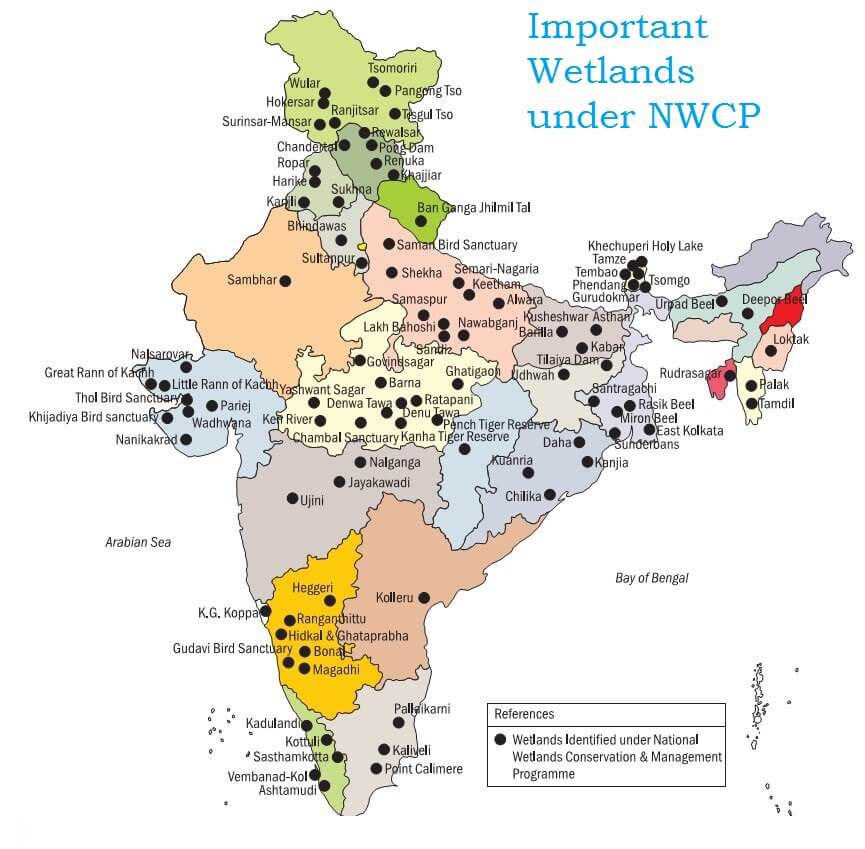
Wetland Conservation and Management Rules 2017 – Provisions
Wetlands are regulated under the Wetlands (Conservation and Management) Rules, 2017. The 2010 version of the Rules provided for a Central Wetland Regulatory Authority, but new Rules of 2017 replaced it with state-level bodies and created a National Wetland Committee, which functions in an advisory role.
The newer regulations removed some items from the definition of “wetlands” including backwaters, lagoons, creeks, and estuaries. Under the 2017 regulations process to identify the wetlands has been delegated to the States.
- Constitution of State Wetland Authority: It has provisions for setting up of a State Wetland Authority (SWA) in every state and Union Territory to be headed by the Environment Minister of the respective state. It is to include a range of government officials. One expert each in the fields of hydrology, socioeconomics, landscape planning, fisheries, and wetland ecology. They will determine the ‘wise use principle’ that shall govern the management of wetlands. “Wise use” can be defined as the principles of sustainable use that are compatible with conservation. This has led to the decentralization of powers. The SWA shall:
- Develop a comprehensive list of activities to be regulated and permitted within notified wetlands and their zone of influence.
- Recommend additional prohibited activities for specified wetlands.
- Define strategies for better use of wetlands.
- Recommend measures for wetland conservation and for raising awareness among its stakeholders and local communities with respect to the importance of wetlands.
- Setting up of National Wetland committee: NWC will replace the Central Wetlands Regulatory Authority and shall be headed by the secretary to MoEFCC.
National Wetland Committee (NWC)
National Wetland Committee (NWC) will be set up for
- Monitoring the implementation of rules
- Advising the central government on appropriate policies and action programs for conservation and wise use of wetlands.
- Recommending designation of Wetlands of International importance under the Ramsar Convention.
- Advice collaboration with international agencies on issues related to wetlands.
- Setting up a digital inventory: It is compulsory for all the state authorities to prepare a list of all the wetlands. Based on this, a digital inventory for wetlands will be created and updated every 10 years.
- Prohibited activities: The rules prohibit the discharge of unwanted waste from villages, towns, cities, industries, etc., and solid waste dumping into the wetlands. Conversion of wetland area for non-wetland purposes, construction of a permanent structure on notified wetlands is banned.
These rules shall apply to wetlands notified by the State government, Central government, Union territory Administrations, and those classified as wetlands of international importance under the Ramsar convention.

Super Good Content
Very very useful site
So kind of you, Vinita
I have never Seen like this its amazing…so useful
Awesome Just love you
This is the most useful sight for upsc. To the point
Largest Ramser site ??
Chilika or Sunderbans mam/sir
Here mentioned as Chilika..but Largest area is Sunderbans .Can anyone clear it pls.
Sundarbans is the largest Ramsar Site in India.
Chilika Lake is the largest coastal lagoon in India.
Tq u Mam/Sir
Beautifully organized things.. just love it
wow wonderful
please add images of species in each wetland and national park,it will be easy to remember in pictorial way.
+1
Thanks for the content and great presentation.
Sir this site is the best among all.
Thanks much for updating the content relevant to exam. Probably the only site I have seen with few imp points on wetlands rather than merely name and state.
this is awesome thank you so much for this sir. its very useful
sir, renuka is not the smallest wetland.
I’m just amazed with your efforts!! Thank you veryy very much!
Guys, if u want to download this entire article than follow these steps
First download this article and then open it
Later, tap the three doted mark and there u will find a share option
And click the share option and there u will find the print 🖨 option , u can thank me later😁😁😁
5 add Hui hai new site update kar do please
Sure, Updated!
Tq so much 😀😊🙏